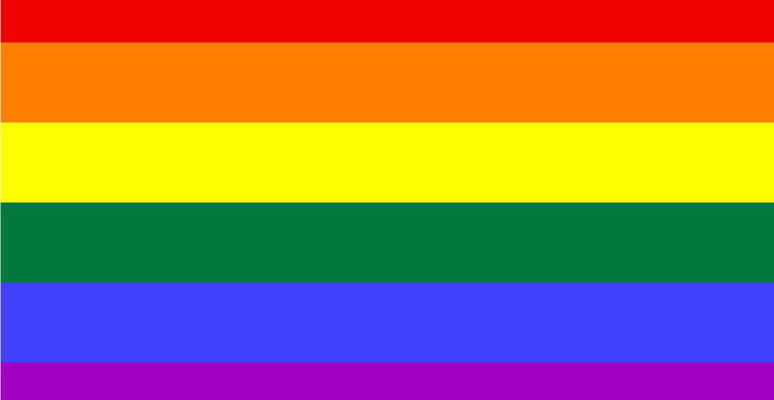
There was some use of similar multi-coloured flags in the USA in the early 1970s as a symbol of internationalism and unity of all people of Earth, but by the end of the 1970s the rainbow flag's connection with gay pride became dominant in the United States.
The original gay-pride flag was hand-dyed by Baker. It flew in the San Francisco Gay Freedom Day Parade on June 25, 1978. (However, it was by no means the first time that spectrum or rainbow colors had been associated with gay and lesbian peoples.) The flag consisted of eight stripes; Baker assigned specific meaning to each of the colours as follows:
hot pink – sexuality
red – life
orange – healing
yellow – sunlight
green – nature
turquoise – magic
blue – serenity
violet – spirit
After the November 27, 1978, assassination of openly gay San Francisco City Supervisor Harvey Milk, demand for the rainbow flag greatly increased. To meet demand, the Paramount Flag Company began selling a version of the flag using stock rainbow fabric consisting of seven stripes of red, orange, yellow, green, turquoise, blue, and violet. As Baker ramped up production of his version of the flag, he too dropped the hot pink stripe due to the unavailability of hot-pink fabric. Also, San Francisco-based Paramount Flag Co. began selling a surplus stock of Rainbow Girls flags from its Polk Street retail store, which was in a gay neighborhood.

Davie Village banners on Davie Street in Vancouver, BC
In 1979, the flag was modified again. When hung vertically from the lamp posts of San Francisco's Market Street, the center stripe was obscured by the post itself. Changing the flag design to one with an even number of stripes was the easiest way to rectify this, so the turquoise stripe was dropped, which resulted in a six stripe version of the flag – red, orange, yellow, green, blue, and violet.
In 1989, the rainbow flag came to nationwide attention in America after John Stout sued his landlords and won when they attempted to prohibit him from displaying the flag from his West Hollywood, California, apartment balcony.
Rainbow flag as a form of protest

The rainbow flag celebrated its 25th anniversary in 2003. During the gay pride celebrations in June of that year, Gilbert Baker restored the rainbow flag back to its original eight-striped version and has since advocated that others do the same. However, the eight-striped version has seen little adoption by the wider gay community, which has mostly stuck with the better known six-striped version.
In autumn 2004 several gay businesses in London were ordered by Westminster City Council to remove the rainbow flag from their premises, as its display required planning permission. When one shop applied for permission, the Planning sub-committee refused the application on the chair's casting vote (May 19, 2005), a decision condemned by gay councillors in Westminster and the Mayor of London, Ken Livingstone. In November the council announced a reversal of policy, stating that most shops and bars would be allowed to fly the rainbow flag without planning permission.
Today many homosexuals and supporters of gay rights often put rainbow flags in the front of their yards and/or front doors, or use rainbow bumper stickers on their vehicles to use as an outward symbol of their homosexuality or support.
On the 14th of June 2004, gay activists sailed to Australia's uninhabited Coral Sea Islands Territory and raised the Gay flag, proclaiming the territory independent of Australia. See also Gay and Lesbian Kingdom of the Coral Sea Islands.




Comments